INTERNACIONAL
Trump thanks group representing families of hostages for Nobel Peace Prize appeal
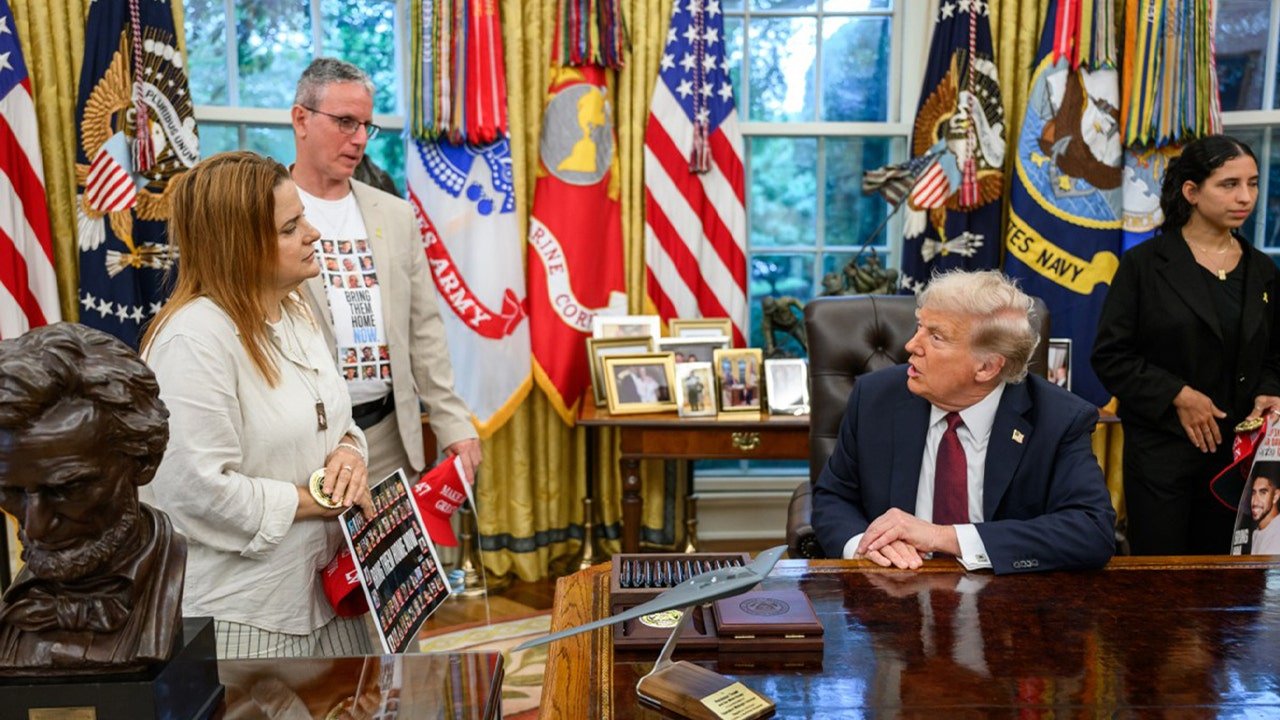
NEWYou can now listen to Fox News articles!
President Donald Trump issued a letter to the Hostages and Missing Families Forum on the second anniversary of the Oct. 7 massacre, thanking them for their appeal to the Norwegian Nobel Committee.
«Since the abhorrent events of October 7, 2023, that saw families ripped apart, children torn from their parents’ arms, and innocent people shot, killed, and raped, I have been resolved to returning all the hostages home, and ensuring the total destruction of Hamas so these horrific acts may never be repeated. These unspeakable scenes have been seared into our memories, and we will never forget,» Trump wrote.
«My entire administration has been touched by the fact that, through the unimaginable pain and suffering of spending two years not knowing where your loved ones are, you have continued telling their stories and advocating on their behalf.»
ISRAEL, HAMAS MEET IN EGYPT TO REVIVE TRUMP PEACE PLAN AHEAD OF OCT. 7 ANNIVERSARY
President Donald Trump meets with freed Israeli hostages Ohad Ben Ami and Raz Ben Ami, and Ilay and Leela David, the siblings of Evyatar David, who is still held hostage by Hamas in Gaza. Sept. 2025. (The White House)
On Monday, the Hostages and Missing Families Forum issued a letter to the Nobel Committee, saying that after two years of suffering, they felt that Trump’s efforts brought them to a turning point. The group also acknowledged the number of hostages released since Trump’s inauguration, giving some families their loved ones and others «the dignity of burial and closure.»
«President Trump’s determination to bring peace made possible what many said was impossible. From the moment of his inauguration, he brought us light through our darkest times,» the forum wrote. «We are confident that he will not rest until the last hostage is brought home, the war has ended, and peace and prosperity are restored to the people of the Middle East.»
«In this past year, no leader or organization has contributed more to peace around the world than President Trump. While many have spoken eloquently about peace, he has achieved it. While others have offered empty promises, he has delivered tangible results that have saved countless lives,» the forum added.
TRUMP ANNOUNCES ISRAEL AGREES TO GAZA ‘INITIAL WITHDRAWAL LINE’ AS ‘3,000 YEAR CATASTROPHE’ NEARS END
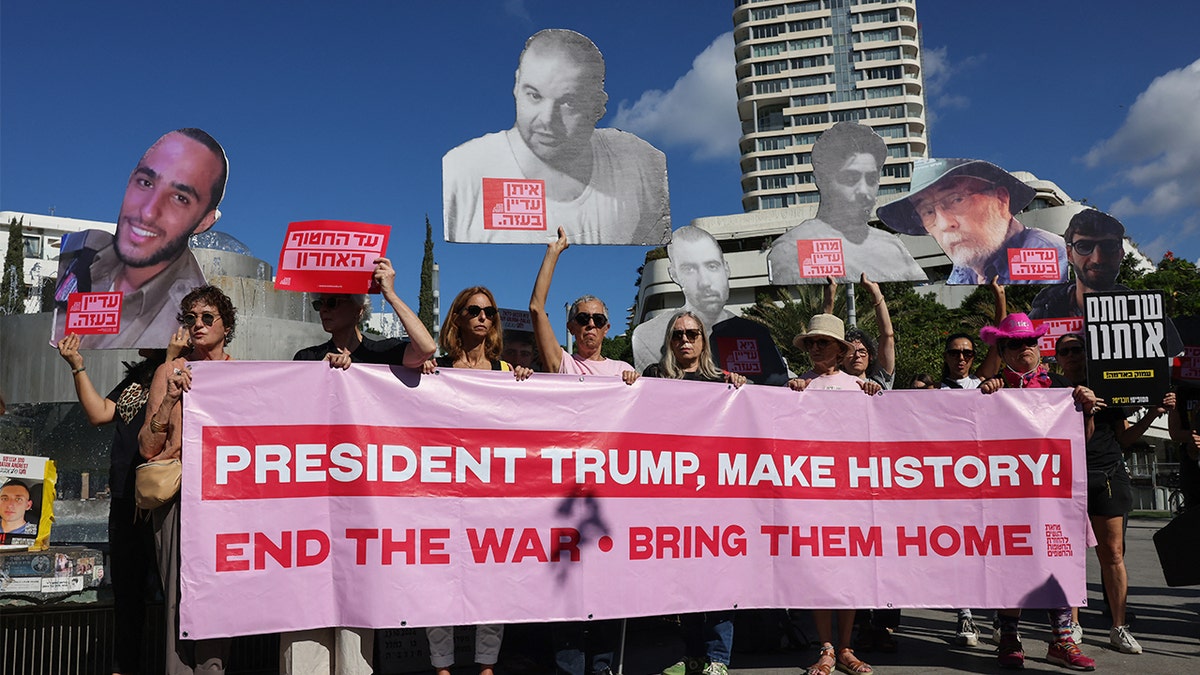
People lift a banner and portraits of Israelis held hostage in the Gaza Strip since 2023, during a rally in Tel Aviv marking the second anniversary of the attacks by Palestinian terrorists, on Oct. 7, 2025. (AHMAD GHARABLI/AFP via Getty Images)
It’s unclear whether Trump will win the prize, but that does not mean he has given up on achieving peace and ending the war.
Trump over the weekend urged the negotiators involved in the indirect talks to «move fast,» but he signaled that he viewed Hamas’ response as positive and called on Israel to «immediately stop the bombing of Gaza.»
Israeli Prime Minister Benjamin Netanyahu accepted the 20-point plan while in the U.S. last month. While Hamas said it was ready to release the hostages, it did not give a definitive answer on Trump’s plan.
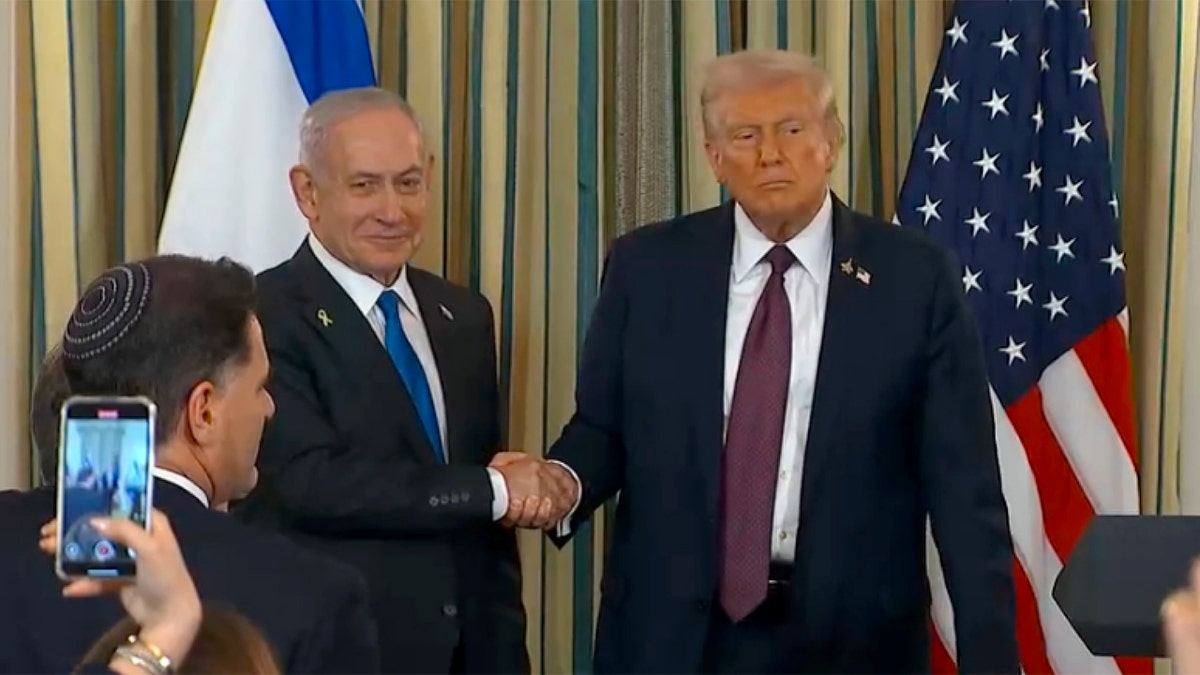
President Donald Trump and Israeli Prime Minister Benjamin Netanyahu in the State Dining Room at the White House on Sept. 29, 2025, in Washington, D.C. (POOL)
CLICK HERE TO GET THE FOX NEWS APP
Secretary of State Marco Rubio hailed Trump’s deal as «a historic opportunity to close this dark chapter, and to build a foundation for lasting peace and security for all.»
Chief negotiators from Israel and Hamas convened in Egypt on Tuesday as negotiations regarding Trump’s peace plan continued. An Egyptian official with knowledge of the talks told The Associated Press that Hamas and Israel agreed on most of the first-phase terms, including the release of the hostages and the establishment of a ceasefire.
Fox News Digital’s Caitlin McFall contributed to this report.
donald trump,middle east,israel
INTERNACIONAL
New Navy Under Secretary Cao to ‘supercharge’ force by ditching DEI, raising standards, modernizing IT
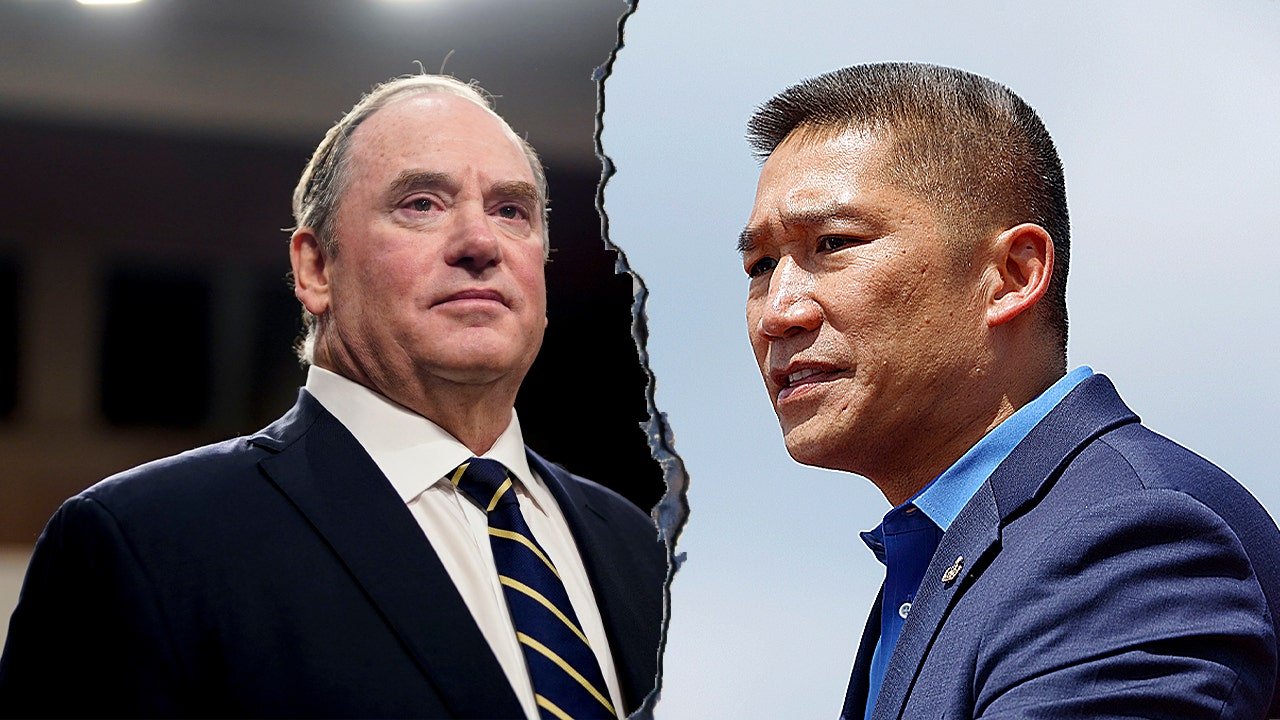
NEWYou can now listen to Fox News articles!
Navy Secretary John C. Phelan has tapped new Navy Under Secretary Hung Cao to lead a sweeping overhaul of the service and «supercharge the Navy and Marine Corps,» including modernizing its business and IT systems.
Cao, sworn in Oct. 3. by Secretary of War Pete Hegseth, returns to the Department of the Navy with direct orders to «cut red tape and raise standards.»
Phelan said in a memo shared exclusively to Fox News Digital that the reforms are to «sharpen readiness, fix faster, and put sailors, Marines, and their families first» as well as restore the Navy and Marine Corps’ warrior ethos.
Cao, a former U.S. Navy captain, is also a well-known Republican figure, who ran for the U.S. Senate in Virginia in 2024 and in 2025, was nominated by Trump and confirmed as the 35th Navy under secretary.
HEGSETH ORDERS ABOUT FACE ON PENTAGON’S SLIPPING GROOMING STANDARDS
President Donald Trump with Hung Cao in 2024. (Anna Moneymaker/Getty Images)
The move follows remarks by Hegseth Sept. 30 to flag and general officers at Marine Corps Base Quantico.
«First and foremost, we must restore a ruthless, dispassionate and common-sense application of standards,» Hesgeth said. «Standards must be uniform, gender-neutral, and high. If not, they’re not standards — they’re suggestions. Suggestions that get our sons and daughters killed.»
Cao’s reforms will start at home and include launching a new inspection system with 60-day repair timelines to overhaul military family housing.
Base dining will shift to healthier, locally sourced menus designed to mirror combat readiness and improve nutrition.
HEGSETH VOWS TO REBUILD MILITARY DETERRENCE SO ENEMIES ‘DON’T WANT TO F— WITH US’

Secretary of the Navy John Phelan greets sailors during a visit. (Courtesy of the Secretary of the Navy)
Outdated IT and business systems will be replaced with modern, mobile-ready platforms to streamline daily operations and empower sailors with tools that work for the first time.
Beyond quality-of-life upgrades, the Navy is targeting full audit compliance by FY2026 to strengthen transparency and accountability.
Recruiting reforms will eliminate DEI-based waivers in favor of merit-only accessions, while reserve forces will integrate more closely with active-duty training pipelines.
Permanent Change of Station (PCS) orders will move faster, and new policies will expand school choice for military families.
On Guam, infrastructure upgrades, from runways to fuel and housing capacity will harden the island’s role as a vital Indo-Pacific power-projection hub.
AIR FORCE TIGHTENS RULES ON TRANSGENDER AIRMEN; SUPPORTERS SAY IT PRIORITIZES READINESS: REPORT
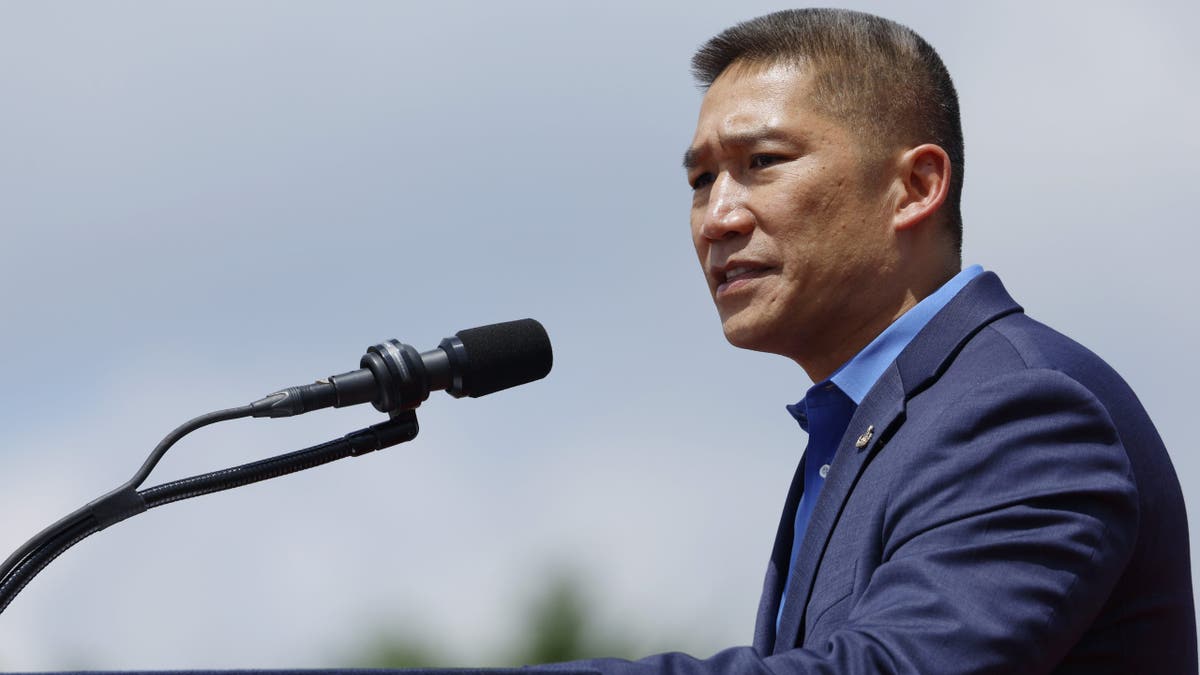
Navy Under Secretary Hung Cao has been tapped to lead a sweeping overhaul of the Navy and Marine Corps. (Anna Moneymaker/Getty Images)
«These aren’t talking points, they’re timelines,» Cao said of the reforms. «We’re ending bureaucratic drift and restoring excellence.»
Cao’s initiatives will also aim to unify family welfare and combat readiness under what Phelan describes as «one quarterback, one playbook.»
On Capitol Hill, Rep. Jack Whitfield, R-Texas, chair of the House Armed Services readiness panel, said Congress would «support the Navy’s renewed focus on lethality and accountability.»
HEGSETH TELLS TROOPS TO RESIGN IF THEY OPPOSE HIS PLAN TO SCRAP ‘WOKE’ POLICIES AND RESTORE WARRIOR ETHOS
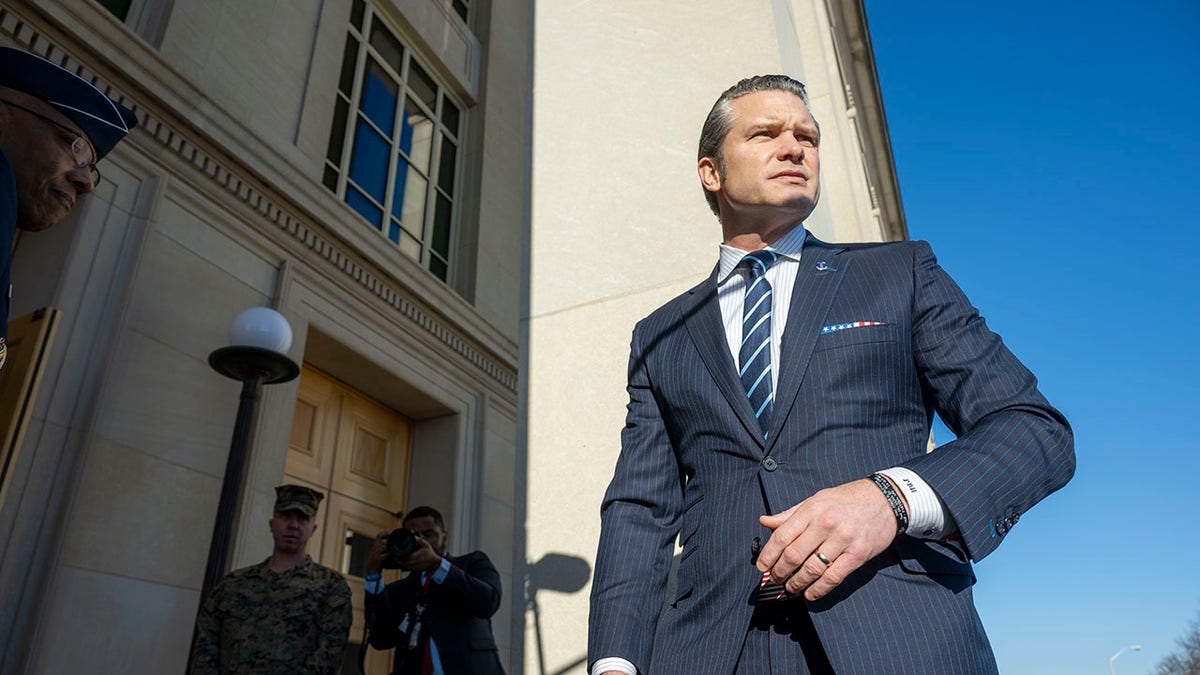
Department of War Secretary Pete Hegseth arrives at the Pentagon. (AP Photo/Kevin Wolf)
A Democratic staffer on the Senate Armed Services Committee called it «an overdue reset» and confirmed oversight «will track results closely.»
The sweeping, new portfolio integrates quality-of-service improvements, modernization, and reserve reform under a single chain of command.
CLICK HERE TO GET THE FOX NEWS APP
«This is about speed, standards, and service,» Phelan said. «When the basics work the first time, ships sail more, aircraft fly farther, and the world’s greatest maritime force only gets stronger.»
Hegseth and Phelan did not immediately respond to Fox News Digital’s request for comment.
us navy,navy,defense,pete hegseth,politics
INTERNACIONAL
Roma, atascos y caos: el insólito tráfico de la antigüedad y por qué recuerda a las ciudades modernas
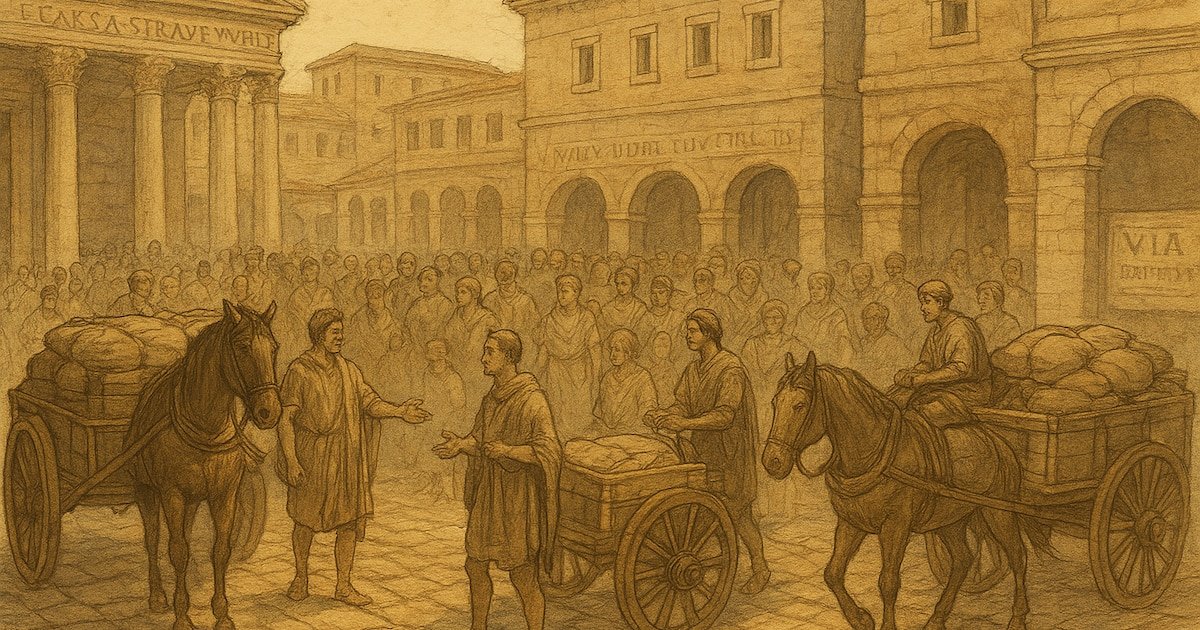
En la Roma antigua, los problemas de tráfico y la búsqueda de estacionamientos ya formaban parte de la vida cotidiana, lejos de la imagen de calzadas amplias y tránsito fluido. La capital del Imperio romano y otras ciudades, como Ostia y Pompeya, experimentaban una congestión que condicionaba la rutina de sus habitantes, según documenta Muy Interesante.
La presión sobre las infraestructuras viales, la saturación de las calles y la falta de espacios para estacionar generaban tensiones que recuerdan a los desafíos urbanos actuales.
El crecimiento demográfico de Roma, impulsado por su papel como metrópoli del Mediterráneo, atrajo a cientos de miles de personas dentro de sus murallas. Esta concentración provocó una demanda constante sobre las calzadas, que, aunque sólidas, no estaban preparadas para soportar el tráfico simultáneo de carros de transporte, vehículos privados y multitudes de peatones.
Las calles del centro, muchas veces estrechas, se convertían en auténticos cuellos de botella. En Pompeya y Ostia, los restos arqueológicos muestran profundas rodadas en la piedra, evidencia del paso incesante de vehículos pesados.
Estas marcas no solo atestiguan la intensidad del tráfico, sino que también reflejan el deterioro de las infraestructuras, lo que obligaba a reparaciones frecuentes y a la imposición de restricciones en ciertos tramos, como señala Muy Interesante.

Uno de los principales factores de la congestión era el movimiento constante de carros de transporte, esenciales para el aprovisionamiento de mercancías en la ciudad. El flujo de estos vehículos, especialmente durante el día, colapsaba las vías principales.
Para aliviar la situación, las autoridades imperiales dictaron normas que prohibían la circulación diurna de carros, obligando a los transportistas a operar durante la noche. Esta medida generó nuevas molestias: el estruendo de las ruedas metálicas y el tránsito de animales de tiro alteraban el descanso nocturno.
Autores clásicos como Juvenal y Marcial se quejaron del ruido que perturbaba la tranquilidad de los romanos, según recoge Muy Interesante. Así, la regulación del tráfico diurno trasladó el conflicto al horario nocturno, evidenciando la dificultad de equilibrar las necesidades económicas con la calidad de vida.
El estacionamiento representaba otro reto considerable. Sin espacios reservados, los romanos solían dejar sus carros cerca de foros, mercados o termas (baños públicos de la antigua Roma, espacios construidos para el baño y la recreación, que incluían piscinas y otras estancias), lo que generaba atascos adicionales y bloqueaba el paso de peatones.
Las inscripciones y textos legales de la época documentan quejas contra quienes ocupaban lugares indebidos. En Ostia, la acumulación de carros a la espera de descargar mercancías provocaba embotellamientos en torno a los almacenes.

En Pompeya, la presencia de postes de piedra delimitaba zonas para impedir el acceso de vehículos, reservando el espacio para peatones y actividades comerciales. La ausencia de una planificación de aparcamientos agravaba la tensión entre la circulación y la vida urbana cotidiana.
Frente a este panorama, las autoridades romanas intentaron imponer orden mediante regulaciones. Además de la prohibición diurna de circulación de carros, se establecieron restricciones de acceso a determinadas zonas, especialmente en torno al Foro Romano, donde se priorizaba el tránsito peatonal y la actividad política.
En algunas ciudades, se instalaron límites físicos como pivotes de piedra, escalones o estrechamientos intencionados de la calzada para disuadir el paso de vehículos. Estas medidas reflejan un esfuerzo consciente por gestionar la movilidad y reducir los conflictos, aunque, como muestran las fuentes literarias, rara vez lograban erradicar el problema debido a la persistente presión demográfica y económica.
La convivencia entre peatones y vehículos era fuente constante de fricciones. Los ciudadanos de a pie utilizaban aceras elevadas y pasos de piedra, como los que aún se conservan en Pompeya, pero el espacio seguía siendo insuficiente. Muchas veces, los peatones debían compartir la calzada con los carros, lo que incrementaba el riesgo de accidentes.
El filósofo Séneca criticó la incomodidad y el peligro de las calles abarrotadas, mientras que Juvenal ridiculizó la imposibilidad de moverse sin ser empujado o pisoteado. Estas quejas reflejan el malestar generalizado ante la congestión y el ruido, según destaca Muy Interesante.

Para adaptarse a esta realidad, los habitantes de Roma desarrollaron estrategias cotidianas. Algunos optaban por desplazarse a pie para evitar la lentitud de los carros, otros programaban sus viajes en horarios menos concurridos y los aristócratas recurrían a esclavos para abrirse paso en las calles más saturadas.
El ingenio y la flexibilidad se convirtieron en recursos esenciales para sobrevivir en la compleja jungla urbana romana. Incluso en ciudades más pequeñas como Pompeya, el trazado urbano revela intentos de controlar el flujo mediante calles de sentido único, zonas peatonales y sistemas de drenaje que influían en el ancho de la calzada. Estas soluciones locales demuestran que la gestión del tráfico era un desafío común en todo el Imperio.
Más allá de los aspectos prácticos, los problemas de tráfico y aparcamiento dejaron una huella cultural en la Roma antigua. El ruido de los carros se integró en el paisaje sonoro de la ciudad, y la congestión se convirtió en símbolo de los excesos urbanos, donde el lujo y el comercio coexistían con la incomodidad del hacinamiento.
El tráfico caótico llegó a ser una metáfora de la propia Roma: una ciudad poderosa y dinámica, pero también marcada por contradicciones y tensiones internas.
La experiencia cotidiana de los romanos muestra que los dilemas de movilidad y congestión urbana no son exclusivos de la modernidad, sino que han acompañado a las grandes ciudades desde hace milenios, como ha documentado Muy Interesante.
INTERNACIONAL
Netanyahu, on 2-year mark of Oct. 7 Hamas terror attack, says Israel ‘not broken,’ vows to bring hostages home
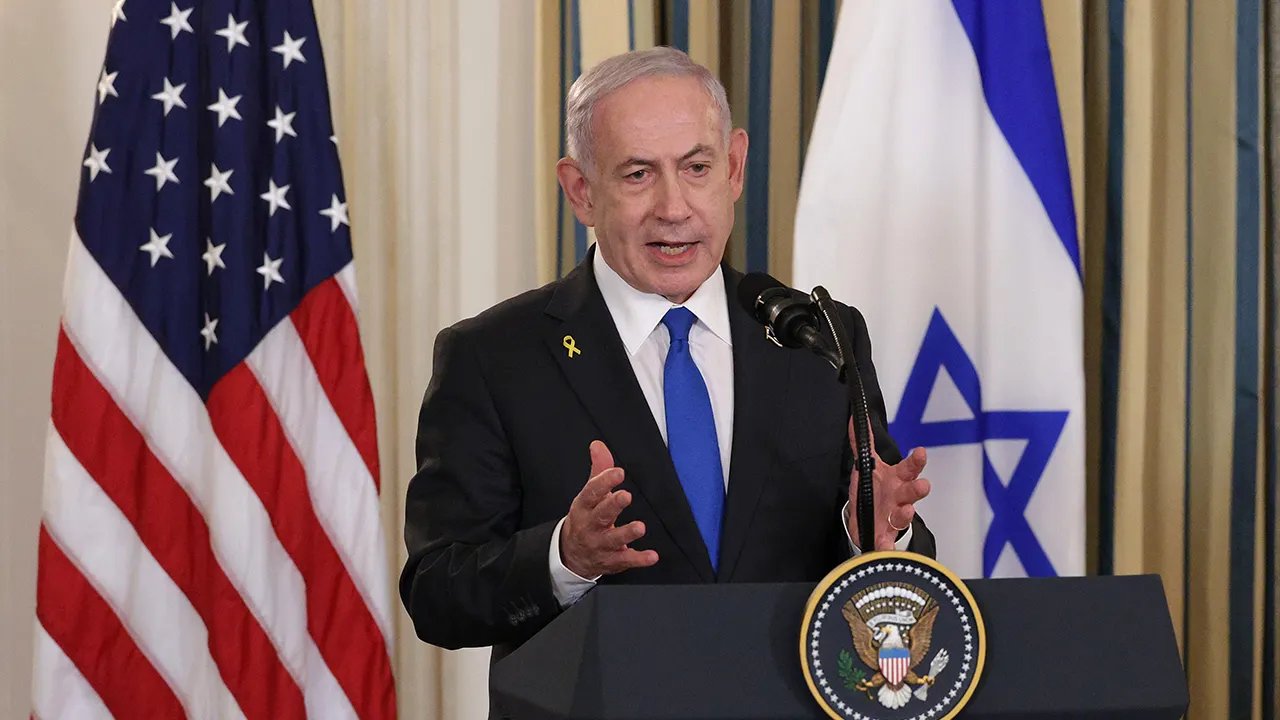
NEWYou can now listen to Fox News articles!
Israeli Prime Minister Benjamin Netanyahu marked the second year since the Oct. 7, 2023, Hamas terror attack in a statement shared on social media Tuesday, calling it «a fateful war for our existence» and declaring that Israel’s «enemies didn’t break us.»
«Infants, children and the elderly were murdered,» Netanyahu said in his remarks shared on X. He added that 251 men and women were taken into tunnels in the Gaza Strip, figures the IDF later released.
Netanyahu said that he and his wife, Sara, «bow our heads in memory of our martyrs and fallen,» while pledging that Israel «continues to work in every way to return all the abductees, both the living and the fallen.»
The Oct. 7 Hamas attack remains the deadliest single day for Jews since the Holocaust.
ISRAEL’S COVERT CAMPAIGN TARGETS HAMAS TERRORISTS BEHIND OCT 7 MASSACRE
Israeli Prime Minister Benjamin Netanyahu delivers remarks during a joint news conference at the White House, Sept. 29. (Alex Wong/Getty Images)
Terrorists stormed Israeli communities near the Gaza border and attacked the Nova music festival, killing families in their homes and kidnapping men, women and children. The Hamas assault ignited a war that remains ongoing.
Netanyahu described the ongoing conflict as «the War of Rebirth on Seven Fronts,» a fight he said was for Israel’s survival and future. «Our bloodthirsty enemies hit us hard, but they have not broken us,» he said. «Whoever raises his hand against us will suffer unprecedented crushing blows.»
He praised Israel Defense Forces (IDF) soldiers and commanders for «waging a fierce war against those who seek our harm on every front» and asserted that Israel has «broken the Iranian axis,» while reshaping the region.
At the same time, he spoke of «immense pride in our country’s miraculous resilience» paired with the «immense pain» of loss.
TRUMP ANNOUNCES ISRAEL AGREES TO GAZA ‘INITIAL WITHDRAWAL LINE’ AS ‘3,000 YEAR CATASTROPHE’ NEARS END
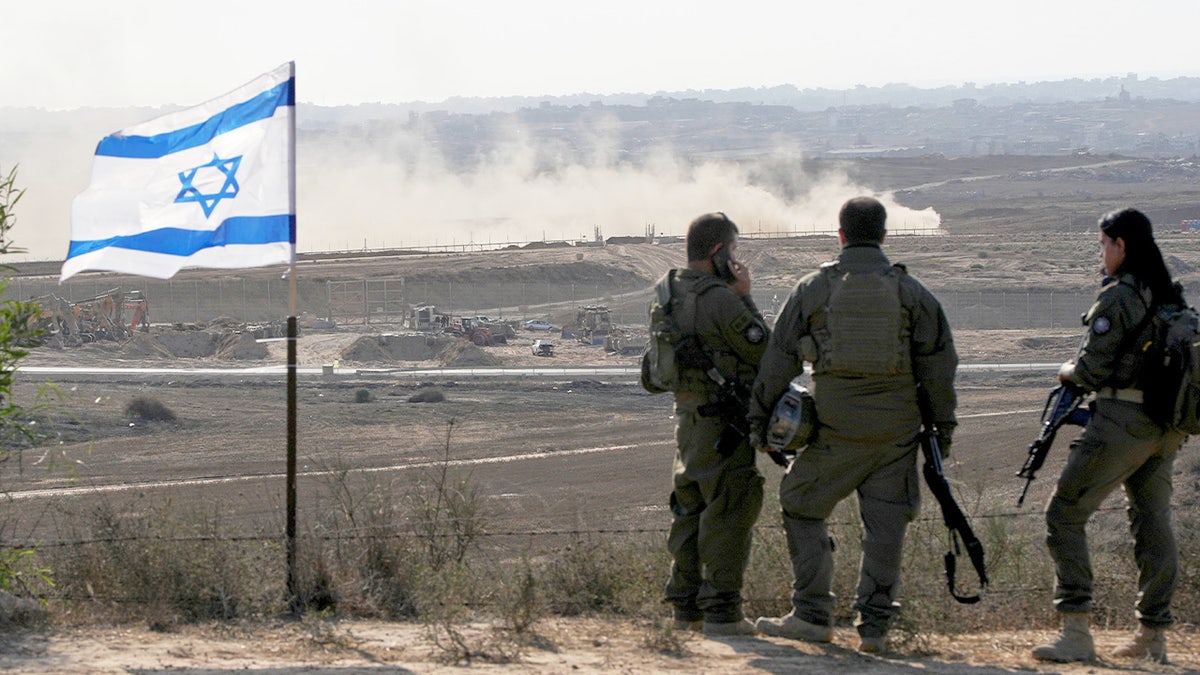
Israeli soldiers watch the northern Gaza Strip from southern Israel, July 30. (AP Photo/Ohad Zwigenberg)
«Our bloodthirsty enemies hit us hard, but they did not break us,» Netanyahu said.
CLICK HERE TO GET THE FOX NEWS APP
Netanyahu concluded his statement with a call for unity, vowing to pursue three central war aims: the return of all hostages, the elimination of Hamas’s control in Gaza and a permanent guarantee that the territory will never again threaten Israel.
«Together we will stand, and together, with God’s help, we will win,» he said.
Negotiators from Israel and Hamas have convened in Egypt this week to discuss details on President Donald Trump’s peace plan to end the war in Gaza and return 48 Israeli hostages.
Fox News Digital’s Caitlin McFall contributed to this report.
israel,conflicts,middle east,terrorism,benjamin netanyahu

 SOCIEDAD2 días ago
SOCIEDAD2 días agoAtacada por ser judía: el aterrador relato de una mujer en Buenos Aires

 CHIMENTOS1 día ago
CHIMENTOS1 día agoMica Viciconte confesó por qué no fue a conocer a su primer sobrino: “Me cuesta, no me hallo”

 POLITICA2 días ago
POLITICA2 días agoTras la renuncia de Espert a su candidatura, el PJ busca capitalizar la crisis libertaria y fortalecerse en las urnas























